1978 – Line Flight Attendant
Note: Be sure to click on individual photos for enlarged images.
After completing my Saudia assignment on October 16, 1978, I flew back to JFK the next day, with two weeks at home before returning to TWA as a New York-based, domestic line flight attendant. Thanks to heavy hiring during my absence, I gained enough seniority to avoid reserve status and hold a regular “line of time,” as it was known, and my rate of pay had increased, although substantially less than what I was leaving with Saudia. However, savings accrued during the past 18 months were more than enough to tide me over.
Except for the brief period just before leaving for London, I had been in a management position, in one form or another, since returning from Pan Am. Although it didn’t pay nearly as much, being a flight attendant opened a whole new world to me. Suddenly, the responsibility was lifted and I didn’t have to bring work home. If I called in sick or went on vacation, someone else would do my job; what a concept!
I successfully completed recurrent safety training and was fitted for a brand-new uniform at no cost to me, thanks to the fact that TWA had changed the design while I was gone. Having learned the fine art of bidding, I was able to hold a 707 schedule for November, with the first trip departing November 7, just one leg from JFK to Washington-Dulles, a quick overnight and then back to New York via Philadelphia
The following day began a regular pattern for the month. We left JFK late in the afternoon for Las Vegas via Phoenix, on an older, straight-pipe 707-331. A generous layover in Tinsel Town was followed by a late-afternoon flight over to Los Angeles for a three-hour sit, then eastbound to Albuquerque for the night. Brother Bill, or his wife Ann, picked me up at LAX and took me home for dinner, then back to the field. Day No. 3 was an easy morning departure, returning to JFK on a through flight via Chicago. Four of these trips rounded out the month. I even managed to enjoy that quick dinner at LAX on Thanksgiving night with family.
La Guardia Option
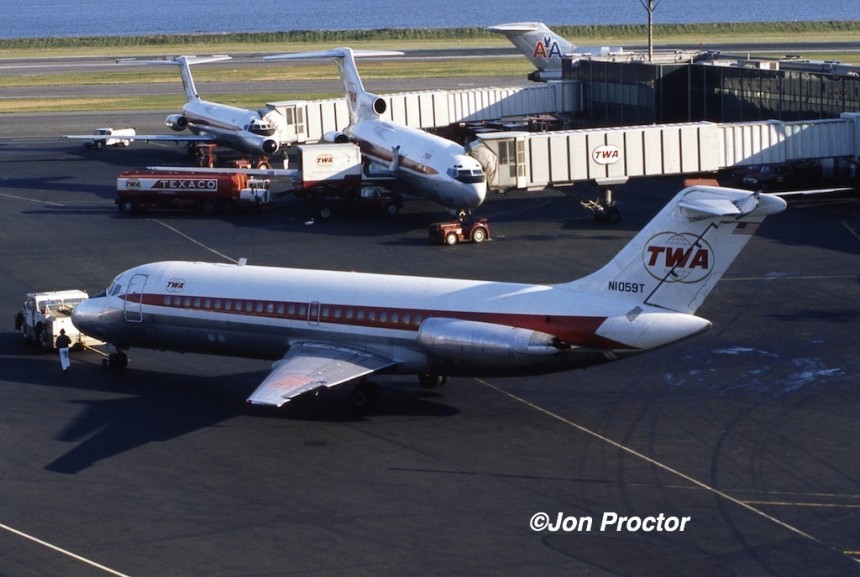
Close-in La Guardia Airport was a pleasant alternative to JFK. Two original TWA DC-9s are seen in this 1971 picture.
New York flight attendants could, seniority permitting, choose to fly out of either JFK or La Guardia Airport (LGA). Trips originating or terminating at Newark (EWR) meant company-provided ground transport there from either JFK or LGA. Often an EWR trip would return to a New York airport, or vice versa.
Driving in from Connecticut, La Guardia Airport was more convenient for me. We flew 727s and DC-9s from that location, making for shorter-segment trips and longer days; nevertheless, I bid a LGA line for December. A closer-knit family of flight attendants tended to fly from this airport, in a much more relaxed atmosphere compared with JFK. Each month someone from the administration department would schlep our mailboxes over from JFK.
I was way too junior to hold much of the Christmas holiday season off that first year, but by sacrificing it altogether, I could hold a much better schedule for the balance of December. My three-day trip overnighted at Columbus (CMH) and Denver (DEN), with two, three and four-leg days, and five days off between trips. Trading around, I got Christmas Eve in Los Angeles, again to be with family.
The Original Nines
Knowing that our DC-9s were slowly being withdrawn from service, I bid and held the type in February, for what looked like a nice, three days on, three-off schedule. TWA’s “original Nines” were the short-body -15 variants, staffed by just two flight attendants. For the month, I was paired up with Rachel Bayer, who I can only describe as a firecracker, great fun to fly with, although the month didn’t start off well.
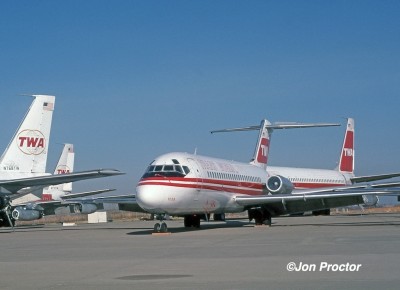
Both the original Nines and straight-pipe 707-331s were leaving TWA’s fleet about the time I worked them. Withdrawn aircraft are seen at the TWA overhaul base in November 1979.
Day One was simple: Limo (ground transport) from LGA to EWR around dinnertime, then work to Indianapolis (IND) via Pittsburgh (PIT). I dutifully reported curbside, opposite baggage claim, and waited. When 15 minutes past pickup time came and went, I called Crew Schedule. “We’ll send another limo,” said the scheduler, “but you may miss the flight.” I pointed out that this was a DC-9 trip, which could not be dispatched without minimum staffing. A pregnant pause followed, then a brief period on hold. “Go upstairs to the TWA counter; a ticket on New York Airways will be waiting for you.” A few minutes later I boarded a helicopter for Newark on a crystal clear night; what a treat!
Rachel was embarrassed when I showed up at the gate. Apparently she had flown the previous month with an F/A from New Jersey, and somehow figured I was going to skip the limo and report directly to EWR, which was our option.
All went well for the rest of the month. Rachel, a smoker, preferred working the “B” position, sitting in the tail for takeoff and landing. I had no problem working “A,” making the announcements and filling out liquor papers, so we hit it off from the beginning. Although the seating capacity varied over the years, including a split 16-first, 50-coach configuration, the Nines were all-coach by 1978, seating 77 as I recall.
But back to the schedule. After a short night at IND, the pattern took us back to PIT, then Kansas City (MCI) via Cincinnati (CVG), another relatively easy duty day. But we paid for it on Day Three, leaving mid-morning to Newark via St Louis (STL) and Dayton (DAY). It would have been quite civil to end it there. Instead we returned to PIT and backtracked to LGA, then did it again, a seven-leg slug.
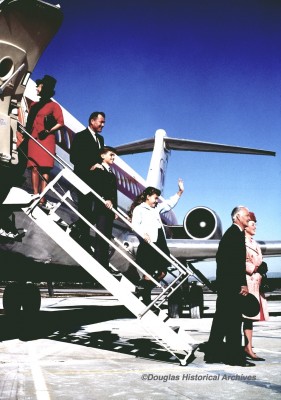
This rosy picture doesn’t reflect the challenge of dealing with rejected carry-on bags and inclement weather.
Our short DC-9s had limited carry-on space. On the two-seat side of the cabin, one could barely squeeze a briefcase under the aisle seat, and even less under the window seat. We had open overhead racks, permitting only coats and hats. A small carry-on luggage rack held the equivalent of perhaps four briefcases and a garment bag. The last four flights of the third day were always loaded with business travelers. To top it off, PIT usually put us at a non-Jetway gate. The agent would hand me a stack of luggage tags for the anticipated pile of luggage that didn’t fit in the cabin, and I would have to move against traffic, carrying items down the narrow integral air stairs to the pavement where a ramp serviceman would move them to the cargo compartment.
The only good news is that we kept the same airplane for all seven legs, so no “bag drags” as we called them, switching equipment. Plus the flights were all tagged together, with no layover time to speak of between segments.
That was my only DC-9 month, fun but not something I wanted to repeat, especially that third-day pattern. Boeing 727s were much easier to work and generally featured more civilized schedules. As with the Nines, the tri-jets still had open overhead bins but more spacious carry-on luggage compartments and galleys, especially on the 727-200 models.
On 727s a month later my late brother Bill and I flew one leg together, from LGA to ORD on March 13. It was strictly by chance; we were both non-routine, off our schedules. As I recall it was a hurried situation with a full load and I barely got up to the cockpit to feed the guys. I should have recorded the event photographically but it was fun being able to make the opening announcement: “On behalf of my brother, Captain Bill Proctor, I’d like to welcome you aboard TWA Flight 343.”
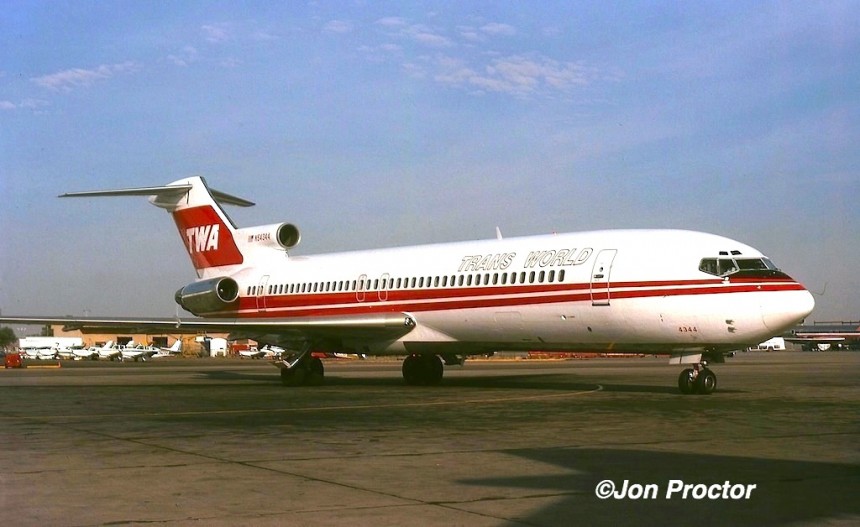
Seventeen new 727-200s began arriving in 1979, complete with enclosed overhead bins. I photographed this one at Albuquerque.
Creative Bidding
I was able to continue LGA flying through the end of 1979. Occasionally a really good schedule surfaced, one that I could hold thanks to lessons learned from savvy flying partners. Commuters generally avoided early morning departures and late evening arrivals. I discovered rather quickly that many others were bidding strictly for the most days off, particularly weekend days. The domestic bid package showed “duty days” based on report and release times, one hour before and 15 minutes after. The total days “worked” for each line were listed at the bottom of the column.
In July, I found what looked like a four-day Wednesday-Saturday trip rotation, but closer inspection revealed that it actually returned home late Friday evening and the release time stretched a few minutes into Saturday. Therefore a weekly four-day trip was really only three days, with weekends off, i.e. 12 days working, not the 16 it showed. The first duty period was semi-brutal, a standard 727 operating from LGA to San Francisco (SFO) with stops at Tulsa, Oklahoma City and Phoenix and pushing our duty limitations; F/As could not be scheduled to fly more than 8 hours in any 24-hour period.
But as a result we had a long downtown SFO layover, leaving late on the second afternoon to Wichita via Albuquerque, then another late-day trip home to LGA via Chicago. Except for the last day, there were no bag drags, the second and third day segments were on “stretch” 727-200s and the service was easy. On the first trip of the month Hugh Downs and his wife were aboard for one segment, my first celebrity, of sorts, since becoming a flight attendant. I flew the whole month with great flying partners and we switched positions mid-way through the first day to break things up. At Phoenix, I jumped off the airplane long enough to pick up burritos from the airport Mexican restaurant, which we woofed down on the way to SFO.
A few JFK trips were sprinkled in, the result of trip trades, which back then were fairly restricted; it was nice to occasionally jump on an L-1011 and work a two-leg trip instead of multiple-segment days.
Early Warnings and Special Assignment
In September, Texas Air Corporation, controlled by the infamous Frank Lorenzo, began buying shares of TWA. Lorenzo, who earlier lost out to Pan Am in an attempt to acquire National Airlines, obviously had set his sights on my employer. His initial overtures to TWA management had been rebuffed but he continued to acquire stock. Trans World Corporation (TWC, parent company of TWA) CEO Edwin Smart assured everyone that the airline was not for sale and the subject received little serious attention from the troops.
Later, that would change.
In late October my first F/A special assignment came along. US Airline Deregulation, signed into law a month a year earlier, allowed the airlines to begin flying to new domestic locations and over previously restricted routes. TWA announced plans to greatly expand Florida service beginning December 15, for the most part from the Northeast. Until then, the Sunshine State only had limited, narrowbody TWA service to Miami, Ft Lauderdale, Orlando and Tampa. West Palm Beach was added to the schedule, along with L-1011s from St Louis and New York.
I was given a handful of tickets on Eastern, Delta and National for a week of sampling the competition’s inflight service. Another flight attendant, Kevin Wachter, drew the same assignment, along with Leif Hansen and Rhoda Quash from the training department. Only one segment was in first class, but the rides were interesting and a contrast in different levels of service and challenges. Later we helped produce an instructional video at the Kansas City training center, narrated by F/A Vera Chandler. It included a cameo appearance by TWA CEO Edwin Meyer, which we filmed at the New York City corporate offices.
Christmastime
Another hodge-podge schedule came my way in December, again on the 727. One memorable day included a hop from STL to Toledo (TOL), a city TWA had resumed service to after many years. We quickly turned around and came back to the hub with two passengers. One, a big-rig semi driver, had rolled his truck and purchased a last-minute ticket; otherwise we’d have had a single customer to entertain. We moved both of them to first class from the back and I wined and dined the pair while my flying partners relaxed.
Christmas Eve that year was spent in a Columbus Airport hotel, devoid of fellow crewmembers. The other two F/As were from CMH and went home to families; the pilots did not lay over with us. My friend Jim Thompson brought me home to dinner with his family on Christmas Day before my return to Newark and a limo back to LGA. This was the first of several holidays away from home or family, but compared with my Riyadh layover the previous year, it was more than welcome.
Into the Eighties
I couldn’t pass up the chance to trade into a JFK trip in January 1980, flying on my beloved Boeing 707. It featured Seattle layovers, a destination that would become a common several years later. But at month’s end, another special assignment opportunity came along and would be among the most memorable of my TWA career: an around-the-world charter flight.
Spring 1980 took me back to LGA for a few months, with trips calling on destinations such as Denver, Amarillo, Nashville, Harrisburg, Colorado Springs Pittsburgh, Washington DC and Florida. Around then fellow F/A Steve Eckhardt and I began occasionally “buddy bidding,” a process where the junior person (me) bids and the senior F/A sacrifices the intervening seniority and takes the first line we could both hold. Initially the process required manual computer insertion by the scheduling people and it got botched on occasion, but we usually wound up getting good trips. Steve lived near me in Connecticut so carpooling saved gas and toll costs. We managed to get tickets on a Nashville layover for the Grand Ole Opry and caught a Cincinnati Reds baseball game on another trip. Steve was a big Reds fan and somehow missed an ORD-PIT segment I worked with the team on board.
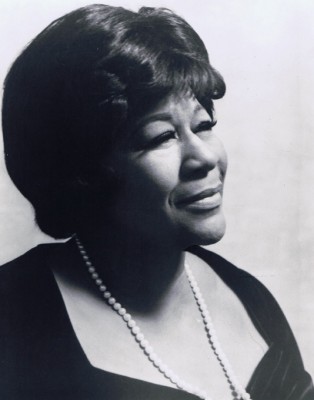
A picture of the legendary Ella Fitzgerald from her official website, http://www.ellafitzgerald.com/
During months when Steve and I were not flying together I worked what was then known as “extra” (XFA) patterns, filling on as an additional warm body on certain flights that justified increased staffing, and wound up working a nonstop PIT-LAX L-1011 flight in first class. Legendary singer Ella Fitzgerald was among my customers. She was quiet and read a book until a baby a few rows behind her began crying incessantly, much to the embarrassment of its parents who were also company employees riding on passes. After a few minutes, Ella walked back, gently picked up the infant and began singing softly. Within a few minutes that baby was sound asleep and back in Mom’s arms and our celebrity was back in her seat, reading. Just before landing I rewarded Ella with a bottle of champagne, which she appreciated; such a kind woman she was.
Flight attendant contract rules allowed us to fly up to 85 hours per calendar month although we could not be scheduled to exceed 75. By trading and picking up trips off the open time board, one could keep adding up to the magic 85 “hard hours,” and also accrue additional credit hours through deadheading and penalty time from longer on-duty days.
In August I pushed the limit, with nearly 100 “pay hours” and more than 84 hard hours. As luck would have it, one of my flights away from domicile cancelled on the last trip. In such cases, the TWA operational planning department took on the task of routing us for the remainder of the pattern. Those good folks were charged with staffing flights in such situations, which was often a challenge with multiple flight disruptions; monthly time limitations were not high of the priority list
On August 29 we wound up at PIT for the night. Another F/A and I were now out of time; even one segment the next day would put us over 85 hard hours. In operations, I was handed a three-segment schedule for the next day, first to Boston, then ORD and back to LGA. My call to “Ops” planning was not what those anyone wanted to hear. “We can’t get another crew there in time and will have to cancel the PIT-BOS flight.” An offer was made to work the segment to BOS, a crew domicile, where surely they could scrape up two F/As to work the balance. “Call me at BOS” came the reply. In the end I didn’t have to. At PIT Ops the next morning we had already been scheduled to deadhead home BOS-LGA on the Eastern Shuttle. All worked out and for me it was “Ca-ching, ca-ching; a nice overtime check.
On a flight inn October I passed 4 million miles in my logbooks, half of it as a working crewmember. As if a message was being sent, we experienced a lightning strike on approach to stormy La Guardia Airport. Let me tell you, those get your attention, to say nothing of the customers.
In January 1981 my schedule included a visit to Rockford, Illinois (RFD), a new TWA city served nonstop from Chicago-O’Hare, a distance of 63 miles. Among the shortest of TWA segments, it was operated with a 727-100. I recall being cleared from takeoff with 747 Flight 770 departing from a parallel runway; the longest and shortest schedules left ORD simultaneously.
At RFD everyone deplaned via the 727’s rear airstairs, walking across the ramp to a terminal building that resembled a red brick schoolhouse. A station wagon transported the crew to Howard Johnson’s for an all-too-brief layover. Bright and early the next morning, the same station wagon was used and also carried boxes of doughnuts we served to passengers en route back to O’Hare.
Fritz Hartman was station manager, an old friend I recognized from his earlier tour of duty at ORD as a station supervisor. RFD service ended less than two years later after disappointing loads. As I recall, Fritz migrated up to Minneapolis (MSP) and eventually went to work for Northwest Airlines

With General and Mrs Jimmy Doolittle; what a thrill. Behind them is fellow raider Dick Knobloch, Crew No. 13’s co-pilot.
April 21, 1981 will always stand out in my mind. At Dayton, the gate agent told me General and Mrs. Jimmy Doolittle would be riding with us to New York. They had been in Ohio for the 39th anniversary reunion of the heroic Doolittle Raiders who bombed Tokyo April 18, 1942 in the first retaliation against Japan since Pearl Harbor. As I’ve mentioned earlier on this website, I was born that very day.
I notified the captain and along with the agent it was mutually agreed to offer the couple first class seats. The space was blocked and upon boarding I invited them to sit up front. Looking around, Doolittle noticed there were only two seats left and declined with thanks, saying they would sit in coach with another Raider and his wife. This man was a true leader of men.
After the snack service, in near panic, I realized that for whatever reason I didn’t have my camera with me. Here was an opportunity for a picture and I was without! After receiving the general’s permission to take one, I quietly asked among the passengers and found a man willing to capture the moment on film. He only took one shot and asked for my mailing address. I never thought to ask for his and held my breath for nearly two weeks until a snapshot arrived in the mail, without a return address. It later appeared in the TWA Skyliner employee newspaper.
I still recall watching in awe as Doolittle completed the New York Times crossword puzzle during the brief flight, in ink.
San Diego Nostalgia
In August I picked up a 4-day XFA trip. The first day included a STL–SAN–LAX 727 flight, bringing me back to my old high school hangout airport for the first time on TWA. My mother was still living in La Jolla and I had enough time to jump off the airplane for a quick phone call before heading up the Coast to LAX. She told me about the days when Dad used to blink the landing lights when flying over their home in Buffalo, giving me an idea. “Look out your window in about 20 minutes,” I suggested. Back on board I asked the captain to flash the lights as we passed over La Jolla. He did, and Mom saw them; what fun!
In October Steve Eckardt and I buddy bid again, this time just for the chance to watch the World Series on layovers; we were probably the only ones to do so. The result was 2-day trips out of EWR with Harrisburg (MDT) layovers, working 707-131Bs (that would be retired by January 1983) via Chicago in both directions. We got to MDT in time for dinner and the games on TV, at a very nice Marriott hotel to boot. This 2-days-on, 2-days-off schedule with limos on both end, was easy to hold, needless to say, but it worked. By the way, the LA Dodgers beat the New York Yankees in six games.
I was usually able to at least get a Christmas layover at a city where I could spend time with friends or family; this year was an exception: Des Moines, Iowa, in a nearly empty airport hotel, part of a 5-day, 15-leg 727 trip. One of the flight attendants called off sick and scheduling was out of reserves; we flew with minimum staffing. The good news: I had New Years Eve and Day off.
Trip from Hell
One of the strangest and most challenging trips I endured was supposed to be easy: A late-evening, one-stop 727 from LGA to Phoenix on January 21, 1982, with a 25-hour layover, then a 2:25 a.m. red eye back to St Louis early on the 23rd and deadhead to LGA with a day to spare before Super Bowl Sunday and a party I had been invited to. I avoided all-nighters but this was too good to pass up, some sun in Arizona while barely breaking a sweat.
It didn’t turn out that way.
Everything was routine until we got back to STL Saturday morning at 6 a.m. The 7:15 nonstop to LGA didn’t operate on weekends so the schedule was set up for a 3-plus hour sit, until 9:35 a.m. Noticing a one-stop flight at 7, which would get us home at 11:10, I called scheduling for permission to deviate from our pairing. For whatever reason the request was denied, so a hearty breakfast was consumed at the employee cafeteria followed by four sleepy flight attendants marching around to stay awake.
Flight 140 left STL on time and should have touched down at LGA at 12:42, were it not for a combination ice/snowstorm moving through the Northeast. We circled for nearly an hour and were finally on approach to the airport when an Eastern 727 ahead of us went off the side of the freshly plowed runway. Time to divert to EWR, which we did, only to learn half-way there that a power failure halted all arrivals; now where? The nearest “alternate to our alternate,” Pittsburgh, was reached nearly four hours after taking off from STL. World War III was in progress there, with multiple diversions arriving in droves, even the crew lounge was oversold. Flight 140, along with other diversions, canceled upon arrival.
Meanwhile, the four of us had been on duty for more than 12 hours and could legally retire to a hotel for another eight of crew rest. Finding us a hotel would certainly have become an issue, and we wanted to get home. An added incentive was double time for anything past 12-1/2 hours on the clock. Eventually we boarded Flight 704, a 707 that had overflown Philadelphia, landing around 7 p.m. at JFK. Although recently sanded, the taxiways were slick, resulting in a crawl to the TWA Flight Center gate.
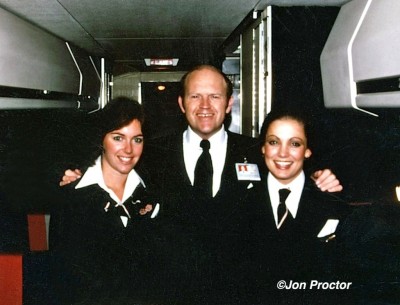
Unfortunately I misplaced most the the crew pictures taken around this time. Here’s one, but no names. They sure were cuties though!
I called scheduling for ground transportation back to LGA and our cars. “It’s going to be a while,” I was told, but a sympathetic soul on the other end of the phone authorized us to take a cab and put in for reimbursement. Finding one was another proposition. The taxi line was empty with a long queue of other people in the same situation. Someone suggested walking over to the domestic terminal for perhaps a shorter line. Half-way there I suddenly saw my feet rise above eye level thanks to a sheet of ice on the sidewalk, and landed hard on my shoulder. Rolling over, I crawled to my feet with help from the other crewmembers, and hobbled on.
We got a cab, perhaps a half-hour later, and rode directly to the LGA employee parking lot. Our cars were covered with snow but group participation got them cleaned off so each of us could transverse the icy streets and highways. I got home shortly before midnight, only to find water dripping from the ceiling in my upstairs bedroom; the ice storm had caused a roof leak. It was the end to a less-than-perfect, 20-plus hour day.
I won’t go into detail about my separated shoulder, except to say that physical therapy went on for several weeks.
Children and The Seven Dwarfs
As a result of the increased Florida market, I found myself flying more Orlando trips. An added plus was visiting my brother Dick and family, who lived in suburban Winter Park. The downside was airplanes full of children going to visit Disneyworld and other attractions in Central Florida. We even went so far as to offer “Kids Fly Free” incentives resulting in multitudes of those little munchkins and it became a challenge to fulfill our policy of feeding them first when they occupied half or more of the seating capacity.
In an attempt to keep the Mickey Mouse Club occupied I occasionally staged a contest. For the first one to name all seven of Snow White’s dwarfs a prize was offered. I operated a small aviation post card company and brought sets of TWA cards along for just such an award. You may think children know the names of all seven dwarfs but usually we would only have one winner, two or three at most.
On one flight I made the competition announcement on the public address system from the back of a 727 and headed forward to retrieve a set of cards from my crew bag. Suddenly a boy, perhaps six or seven years old, who probably thought the announcement came from the captain, bolted from his seat and ran up and banged on the cockpit door. This was back when we had a set code with the pilots, with a certain number of knocks. I don’t know if the little tyke hit the right ones or not, but the flight engineer opened up and the boy walked in proudly blurting out, “Grumpy, Happy, Sleepy, Bashful, Sneezy, Dopey and Doc!”
Needless to say, the pilots were a bit surprised. But as I leaned my head into the cockpit to explain, the captain laughed and said, “The little guy got all seven right!”
There were more fun situations with children but a more serious example sticks in my mind to this day. I was working a flight from the West Coast to St Louis. Prior to regular passenger boarding, the agent brought on a woman and daughter of perhaps 10 or eleven, with a broken leg. The cast was up to her hip so we placed her at a bulkhead seat, propped up with pillows and blankets. The mother kissed her good-bye and left. Our unaccompanied youngster seemed apprehensive but calmed down once we were on our way.
While talking with her later in the flight I learned that she was going to stay with her father for the first time since a divorce split up the family. There were tears in her eyes as she talked about not really wanting to go and I quickly changed the subject. We sat together for awhile and I told her about neat things to do and see in St Louis, then got up to leave when she said, “Could you get a nurse to help me get in the bathroom?” Well, I wasn’t a nurse but more importantly not a woman either, and one of the other flight attendants took care of her.
When we landed at St Louis, I had the girl wait until everyone was off the airplane then brought a wheelchair into the cabin; her father was waiting in the gate area. Trying to be brave at the forward passenger door, she thanked the other flight attendant and I bent over to say good-bye. Obviously scared at the prospect of meeting her dad, she put her arms around me, started crying and wouldn’t let go. After a minute I told her to be strong and managed my best smile as a skycap wheeled her inside. Back in the airplane two other flight attendants were in tears; I guess we all were.
To International
On a trip in April 1982, one of my flying partners asked if I was going to bid international that summer, suggesting I “come on and fly with the big kids!” That meant barely holding a scheduled line of time, but my sense of adventure overcame common sense and I submitted a bid. Lo and behold, the transfer came through, effective June 1, and I held London trips. But here again, work rules worked in my favor.
There was a quarterly flying limitation on international, with June being the last month of the second quarter. On domestic in April and May I flew high time and had only enough time left to take one but not two London trips. Crew schedule took me off my entire schedule and “balanced” me on a 5-day pattern to Cairo. I received base pay, 65 hours for only working five days, then bid back to domestic in July. I recall JFK Domicile Manager Don Fleming telling me I might have set a record for the shortest time on international.
That turned out to be my only Cairo trip with TWA. After a Rome layover, I worked a 747SP onto Egypt via Athens, for a short overnight top, coming back the same way. It was also my only ’SP assignment.
I spent the balance of that summer on international, holding London and Madrid trips, plus one to Milan, the result of a trade. With the fall schedule all but guaranteeing reserve flying, I transferred back to domestic and pretty much took up residence at LGA. My first trip in October cancelled and I knew scheduling was scrambling to cover flying. A call to volunteer and boost my monthly hours brought a quick response: “Can you go out today?” Yes, I can. “Thanks, we owe you!”
I was quickly assigned a 2-day trip that began with the infamous Flight 5, a dinner service operating from JFK to Miami with an all-coach, 187-seat 707. The pattern was ultra-junior, offering barely 10 hours in Florida before taking a one-stop trip up to STL, with the same airplane, then a 2-hour sit before pressing on to Newark and a limo back to JFK. Having run out of warm bodies to work the trip, we departed with a full load and only four flight attendants instead of the usual five or six. Seventy-plus kosher meals and 15 or 20 wheelchairs later, we staggered off the airplane for a short night’s minimum rest.
I heard one of the flight attendants forced to work Flight 5 or fly the telephone (reserve) had T-shirts made up, proudly stating “I Survived FLIGHT FIVE!”
The Great Blizzard of ‘83
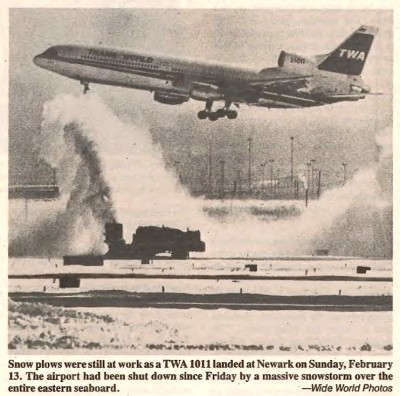
A picture from the TWA Skyliner reflects conditions at the New York Airports February 13, the day I returned.
Winter flying is always challenging in one way or another. I was finishing up a 4-day trip on Friday, February 11, 1983, a three-leg 727 from STL home to LGA via ORD and CMH. Meanwhile, a major snowstorm began hitting the upper East Coast that afternoon, dumping copious amounts of snow from Washington DC all the way up to Boston. As we were getting ready to leave O’Hare, an ops agent came up with a message: our Flight 594 would cancel on arrival at CMH. Westbound Flight 597 was to cancel at LGA and re-originate at CMH, where we would take it to STL, along with what was known as DISPO (disposition) later.
Somehow scheduling found us airport hotel rooms there as numerous flights headed to the East Coast had cancelled with plenty of passengers to put up overnight. Our crew was now at the mercy of operational planning and broken up. The next morning I worked a 727 segment to San Francisco, then back to New York the Sunday on Flight 800. With the system upside down, we operated with an L-1011 instead of the scheduled 747, thus ending day 6 of my 4-day trip. New York airports had been closed since noon Friday and JFK only had one runway open when we got back; most flights were cancelled or long delayed.
In the terminal, pillows and blankets along the walls provided evidence of the 750 people who spent the night stranded there, some on parked airplanes. Because I was scheduled to return to LGA, a cab took me to that employee lot. My car was pretty well buried from the 17-inch snowfall. As I struggled to dig it out, four rampers from another airline came by and pushed me out of the parking spot; bless those boys! It was a bit of a crawl home but, indeed, I had survived the great blizzard of ’83.
In March I picked up a nice 727 trip with a Ft Myers layover and some warm weather and returning nonstop to LGA. We were still using the old airport, Page Field (FMY) with its 6,400-foot runway. My previous trips through there returned to LGA via Tampa, but this pattern was nonstop. Station Manager Ron Horn had a fuel truck stationed at our wing, ready to add fuel depending on the final passenger count. The 727-200 could only make LGA nonstop with a reduced passenger load and no freight. All the passengers showed up and we had to make a pit stop at Orlando. As I recall it was the only time that happened to me on domestic.
Commuting to St Louis
When the New York domestic flight attendant flying began to dwindle it became obvious that I would wind up on reserve and perhaps be displaced to St Louis, our junior domicile. Instead, I put in a transfer and began commuting in July. Over the years I vowed not to do so, especially after my Saudia days on an ad-hoc basis. But the handwriting was on the wall, and I even considered moving.
Now my bidding strategy took on a whole new slant. With our frequent New York-STL schedule, I was able to fly in the first day of my trip, usually out of LGA, with plenty of backup, and then work three-day trips. When possible I put them back-to-back, two patterns with one night in a STL airport hotel. It seems to me the going rate was around $40 per night, thanks to the many properties close to the field and numerous commuters, mostly pilots. Time off at home was three days or more and occasionally six or seven. However, let no one kid you: commuting is stressful and tiring. I kept my eye on New York staffing levels, with hopes of getting back, even if it meant flying reserve.
Mad Dogs
I headed to Kansas City in August for training on the McDonnell Douglas MD-80 (DC-9-80), which acquired the nickname “Mad Dog,” among other unpleasant identities. It burned something like 40% less fuel than the 727-231 with about the same passenger capacity, but at a price. The cockpit was tiny, no longer offering the flight attendant a place to take a break, and the galleys were about half the size of our 727s. Perhaps the hardest thing to get used to was lower overhead bins. Handing a meal tray to a passenger in the window seat resulted in a nasty crack to the head and just about the time you got used to that, it was back on a 727 trip. Relearning became necessary when returning to the Mad Dog. My first trip was a STL-SAN turnaround in September. The only good thing about flying these airplanes was schedules that allowed easier commutes; otherwise I stayed as far away from them as possible.
In October I returned to Kansas City for Boeing 767 training, although it would be some time before actually working the type. At the end of the month I got a couple of days of PTO – personal time off, to join long-time friend Dan McIntyre, and many other airline enthusiasts, for a nostalgic ride on the last TWA 707 service, from Miami to New York October 30. Upon arrival at JFK we learned that the airplane was going to operate back to Kansas City (MCI) the next day, substituting for a 727 in order to get back to the overhaul base. Dan and I, along with a few others, retired to my condo in Bethel, then trekked back to the airport and rode Flight 749, JFK-ORD-MCI. I flew back home a day later for a welcome two-week vacation.
My December schedule included BDL (Hartford) layovers, including one on Christmas Day; so near to home, yet so far. However, it sparked my interest in possibly commuting from that airport instead of LGA. Parking was cheap and later I obtained an employee-parking permit. Driving time from home was nearly the same and there were no bridge tolls.
January 1984 was a challenging weather month from the beginning. On my first trip, a 727, we landed at Harrisburg (MDT) in a snowstorm. There were no Jetways at the field then, and I brought an unaccompanied minor into the grate house, and then headed back to the airplane, just as the loading stairs truck burst a fuel hose and caught fire! Running up the steps, I started yelling for the passengers at the top of the steps to get back in the airplane, pulled the door closed behind me and hit the evacuation alarm. One of the other flight attendants was already sending people out the tail exit and we cleared the cabin in well under a minute, thanks to a light load. Meanwhile, a ground mechanic put out the truck fire and customers were allowed to retrieve their carry-on luggage. It was my first and only aircraft evacuation.
Day two was not a whole lot better. After working back to STL, then over to Louisville and back, we took a 3-1/2 hour, weather-related delay and ended a nearly 16 hours on duty, at Wichita, far too late for our scheduled return to STL the next morning. At some ungodly hour that night, our friends at operational planning called: “Be at the airport by 0700; you’re going to ferry to Palm Springs.” Palm Springs??? Okay, we’ll be there.
Imagine our surprise the next morning when there was no airplane in sight at the field; we were “plane-less.” With all the weather issues many airplanes and crews scattered about. But fear not: minutes later a red-and-white 727 appeared and dropped its airstairs without shutting down engines. STL was out of flight attendants so the airplane with just pilots dropped in to pick us up.
We ferried to PSP in order to operate a single segment with only a handful of passengers, a 45-minute hop to Phoenix, and then deadhead back to domicile, where I caught another flight home. The Harrisburg adventure left me almost voiceless with laryngitis and a stuffed-up head; I called off sick.
The rest of winter only increased my desire to get back to the New York domicile, but it wasn’t yet in the cards. Commuting prompted me to bid back-to-back trips I’d never have flown otherwise. One, with an MD-80, left STL at 9:55 p.m., out to Seattle and Portland, with a 25-hour layover, then returned the same way, arriving STL at 5:30 a.m. The good news was that I could get an inexpensive hotel day room and do it again that evening. Upon return the second time around there was time for breakfast, then a 7:40 a.m. ride to LGA and home.
The MD-80 wasn’t the fastest airplane in the fleet. St Louis to Seattle was a 4-hour trek usually featuring light loads. We were done with the cold snack service in 30 minutes or less, then faced staying awake for another 3-plus hours. Nearly all the passengers slept and there was nothing to keep us busy. Up front the pilots were glad to have a little company, but the drop-down jumpseat was uncomfortable. Those were long nights.
Home Again
My transfer back to New York finally came through, effective May 1, 1984, after having commuted 34 times in 10 months. I was happy to be a reserve flight attendant, even when scheduling sent me to Kansas City on temporary assignment for one trip, then St Louis until month’s end. From June onwards I was able to hold a regular line of time. The trips were not great but compared to reserve or commuting I had no complaints. Then in August I managed to hold a reserve line with 12 consecutive days off. Coupled with two vacation days I got the second half of the month off for two glorious weeks at Newfound Lake in Bristol, New Hampshire.
By chance I held a nice November schedule on the L-1011, although it was not without rough spots. The second trip departed on Election Day, a short segment to Philadelphia (the result of a schedule change), then one stop to LAX.
Somewhere over eastern New Mexico and right in the middle of a meal service, the captain put out an all-call on the interphone. We were shutting down the center, No. 2 engine and proceeding to Albuquerque (ABQ). First question: how much time do we have? Answer: about 15 minutes; you’ve never seen meal trays yanked from the customers so quickly.
Upon landing, the station manager came aboard and said he had protected all the passengers on other flights, as he didn’t expect any quick resolution to our engine problem; at the time ABQ did not have in-house maintenance. But about the time we were ready to unload them, Planning told us, not so fast; they were going to ferry another L-10 from LAX. Six hours later one showed up and we worked it on to LAX; on-duty time: 18:09. At the hotel, Captain Wes Shipstead bought a round for the crew, pilots and flight attendants alike. We were still legal for our return LAX-JFK trip the next afternoon and wouldn’t you know it, I got check-ridden by supervisor Ray Terry. He was merciful nevertheless.
Through an incredible stroke of luck I held Christmas off, then greedily picked up a trip for the money, a three-day pattern. By the second day my scratchy throat and turned into a full-blown head cold. I followed the “Thou Shalt Not Call Off Sick Over Christmas,” and toughed it out, but everything caught up with me on the last leg, a scheduled deadhead back to domicile. Despite cooperation from the flight engineer, who brought he cabin pressure back up ever so gently during descent, an ear block turned into a burst eardrum. I spent the next month recuperating on the ground, and nobody hung a medal around my neck for working an extra trip over the holidays.
The Toe Caper
One of my more embarrassing experiences occurred less than a month after returning in February 1985. In the middle of the night, I broke my right “pinky” toe en route to the bathroom in a DEN layover hotel. The emergency room doctor taped it up, told me to live with it and sent me back to the hotel. I managed to hobble around and work to STL and ABQ the second day, and then had trouble getting my shoe off at bedtime. Once I succeeded a swollen black-and-purple foot stared back. There was no way to work home the next day so I called schedule and was set up to deadhead home via Kansas City. There was one seat left in first class, which turned out to be next to TWA President Dick Pearson, who I’d never met. As I settled in with a big sock over my right foot, he smiled and said, “Should I ask?” No. We actually had a nice conversation on the flight but the combination of going out on a second industrial injury in less than two months, then exposing a damaged foot to the company president was beyond humiliating.
Otherwise a Good Year
By now I had earned 30 days of annual vacation and was able to creatively bid two more weeks free in August 1985 for another New Hampshire holiday, then a month in November for a long-planned trip to New Zealand and Australia. There were challenges when United’s pilots struck for 29 days in May and June. Other than constantly full loads things went relatively well. I served dinner to Mr and Mrs Jack Lemon on a LAX-JFK L-1011 flight and buddy bid most of the year with Steve Eckhardt. We had a lot of fun
But things didn’t start well in 1986 and only got worse. On January 28, 1986, I was working a LAS-PHX-JFK L-1011 flight. We were on the ground at PHX when Space Shuttle Challenger exploded, just as our airplane was about to leave the gate for New York. I was in lower-deck galley setting up carts when Steve came down and said, “The Space Shuttle crashed.” A female flight attendant followed, in tears. The captain made an all-call on the interphone and told us not to make any P/A references; none of the passengers had a chance to hear about it before boarding and there was no use upsetting them. About halfway across to JFK, a passenger who had been listening to his radio (illegally) on earphones asked if I knew what happened. Otherwise everyone was spared the tragedy until we landed.
Another Helicopter Ride
Steve and I flew Newark trips together again in February, driving there and thus avoiding a limo ride. On February 12, our L-1011 lifted off in the morning sun for Phoenix via St Louis and a nice long Arizona layover, we thought. After only a few minutes the captain reported a problem raising the landing gear. Later he advised we were proceeding to JFK, where there would hopefully be a replacement airplane waiting; between troubleshooting and dumping fuel we were in the air two hours. Of course there wasn’t another TriStar sitting around, and our flight was canceled, presenting a dilemma: our car was at EWR and we had technically returned to the JFK domicile, so TWA didn’t owe us transport back to Newark.
By chance I had earlier won a free pass on New York Helicopter by filling out a quiz in the local airport newspaper, and kept the certificate in my crew bag. To avoid the goat rope of ground transportation to EWR (via Manhattan and a bus transfer) we decided to buy Steve a one-way ticket, use my freebie and split the cost.
New York Helicopter was in the TWA Flight Center then. We approached the gate where an Aerospatiale SA-360 Dauphin was about to depart. The agent glanced suspiciously at my pass authorization and paged a supervisor. Looking at us, still in uniform, the boss man promptly tore up the pass and told the agent, “Fuggetabout it; just put ’em both on!” We didn’t know about the LGA stop and got a bit jittery as free riders, but were not bumped. Less than an hour later we retrieved the car at EWR and drove back to Connecticut.
Storm Clouds
After being rescheduled as a result of this trip cancellation we got back on our regular pairings and enjoyed some Phoenix layovers, including one with an extra 24 hours there when St Louis was hit with a snowstorm.
But another storm hit TWA a month later.
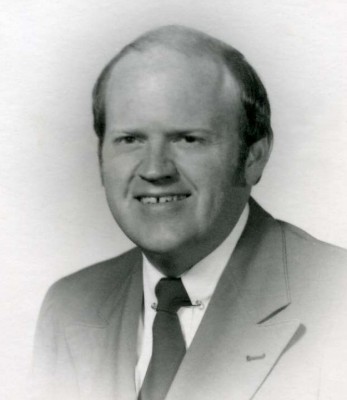
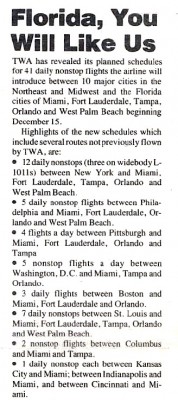
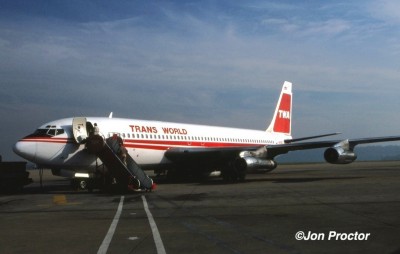

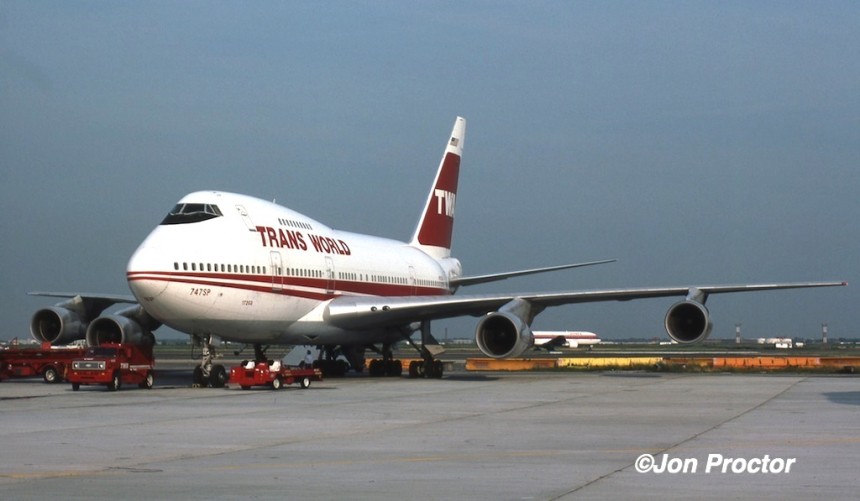
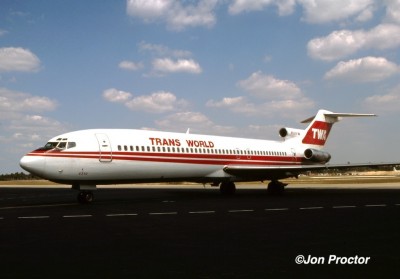
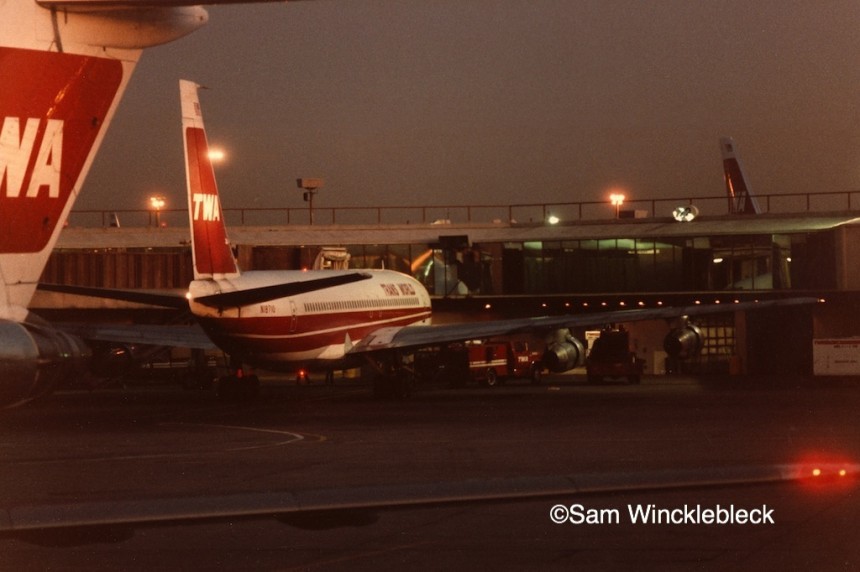

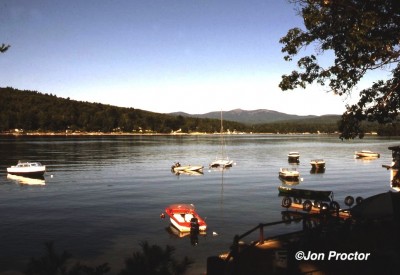
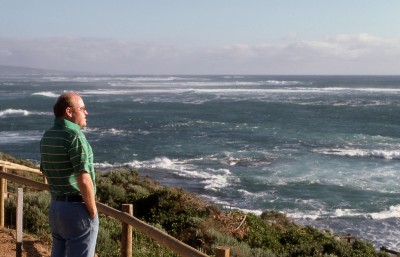
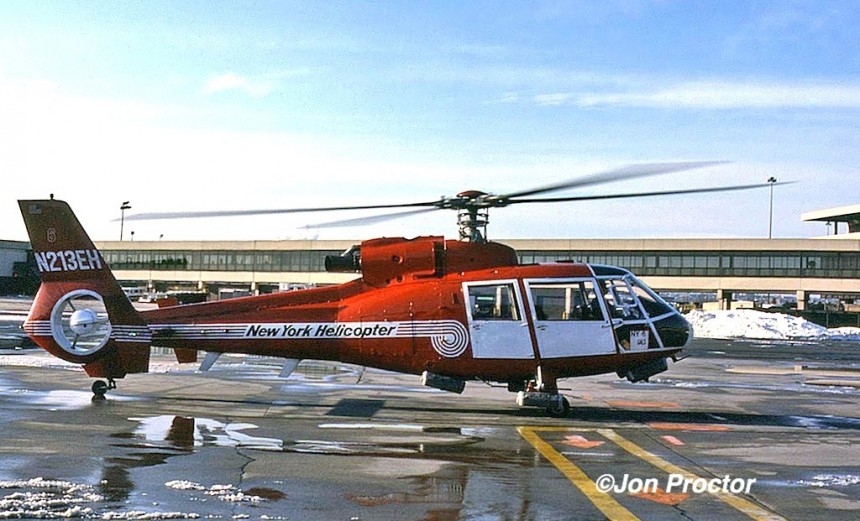
Great stories Jon, keep them coming. They bring back fond memories. Paul
Jon, you have the talent for writing spellbinding stories. Thanks for taking me along. My life with Garuda (early 1950s) was much simpler, but I could place myself in your shoes. So many unexpected things you had to deal with. Neat to be able to look back. Thanks for sharing. Art
Jon, another example of your excellent journalism, harking back to your days as editor of Airliners Magazine! We miss seeing you at the hobby shows and conventions, and hope you’ll pop into one of them this year. Keep well.
Rick
Hello there Jon, I really enjoyed reading about your travels. I worked for TWA from 1955 until 1960. I was based at CHI out of MDW. I usually worked the flight from MDW to LGA and back. It was a very memorable time. Many thanks, Judith
Jon,
Just spent an interesting hour reading your latest post. I smile with the memories your words bring forth.
Please watch for our Luncheons, and plan on visiting. I’d love you to speak to the group at large.
Our Summer Luncheon will be June 7th, at Porter Valley Country Club. Please be our guest.
Hugs
Terrie
Thank you, Terrie; I remember you from the good old daze! Sorry I won’t be in L.A. for the LA Ambassadors luncheon, although I’m still a member. Down the road I hope,
Jon
Hello Jon !
As usual “BRAVO”
Best rgds from France marc
Jon, I recall many happy times aboard Try Walking Across. Age 12 (1954): AROUND THE WORLD including TWA L049 Cairo-Athens-Rome. More often DC-3/4/6 & 6B, Viscount, B337 Stratocruisers across Pacific & Atlantic. Even had a BOAC Comet 1 scheduled (Saw them parked forever)! Domestic TWA: Martin 404 BAL-CVG, L749 GVG-BAL
FIRST JET: TWA 707-331-pipes BAL-SFO, refueled Mid-Con (Short-legged & dirty-contrail SOB) LAST TWA: MD-80 into STL, FAs in tears, ALMOST THE END (TWA>AAL merger).
You and I met at Boeing Field Museum of Flight when AIRWAYS launched. I read, ENJOYED, and just donated ten years of AIRLINERS. Still have first ten years of AIRWAYS for anyone who would treasure them as I have.
ALL THE BEST, JON!
Dr Norman L Wherrett Jr Neuroproctologist-Retired
Dean Emeritus, College of Neuroproctology
Edinburgh University [Founded 1583]
RESIDING:
16808 NE 104th Court
Redmond, WA 98052
nlwherrett@frontier.com
Many thanks for the kind words and memories; we lived the Golden Years of civil aviation! Best Regards,
Jon
I’m hanging on your every word. Good going mate!
Thanks, Jay; good to see your name pop up!
Hi, Jon,
When are you going to continue “An Airline Career” with the 1986 strike portion? It was a fascinating, albeit sad, time for TWA, and the story needs to be told. I know you went to work and would respectfully like to hear your perspective. You have an incredible memory, and are a great storyteller.
Please consider continuing on, as difficult as it might be.
Thanks.
Jeff
Thank you, Jeff; it’s on my “to-do” list, and yes, it will be difficult! Best Regards,
Jon
Jon, this is one of the most fascinating stories I have encountered on the web. Your career has been so rich. I eagerly wait your next installment. Please soldier on with this project.
Hey Jon;
Thanks for the trip down memory lane. Awesome stories! I was with TWA from 1977 to 2003 when AA furloughed us…sad!
While some were recalled years later, many awesome TWA’ers moved on. I didn’t realize it then, but we had it all in a silver platter;
a legendary airline with amazing Flight Attendants going to exotic international destinations. Times have changed! The Journey is not the same. That door closed, other doors opened, but the journey is not the same. We were blessed!
Thanks for your kind words, John. We were indeed blessed during the happy times of TWA!